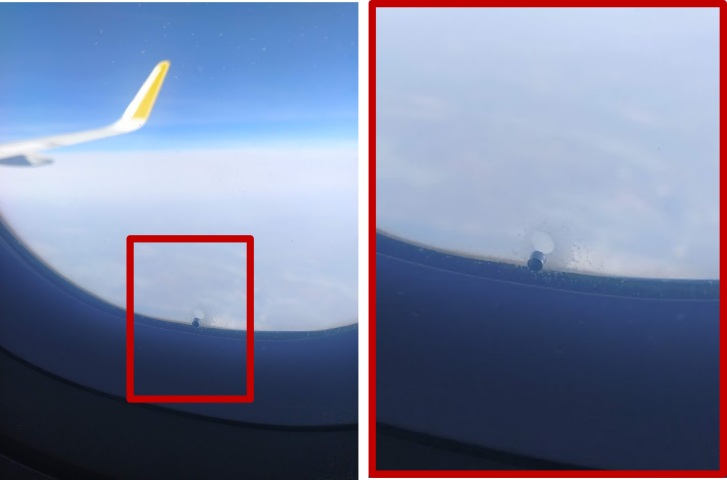Introduction
Every time I take a flight, I can’t help but notice the peculiar little holes in the airplane windows, leaving me curious about their purpose. Airplane windows are not only marvels of engineering that provide passengers with a breathtaking view of the skies but also play a critical role in maintaining cabin pressure and safety. One essential aspect of these windows is the presence of bleed holes. In this article, we will delve into the science behind these small yet crucial openings, unraveling the mystery behind their existence and explaining how they contribute to pressure equalization and passenger safety.

The Anatomy of Airplane Windows
Airplane windows consist of three layers: an outer pane made from strong materials like acrylic or plastic, a middle pane with a bleed hole, and an inner pane that serves as a protective barrier for passengers. The outer pane is designed to withstand the pressure difference between the cabin and the external environment, while the middle pane with the bleed hole helps manage pressure across the panes. The inner pane remains unsealed and provides an additional layer of insulation.
The Physics of Bleed Holes
The purpose of the bleed hole is to equalize pressure between the cabin and the gap between the outer and middle panes. As an airplane ascends, the air pressure outside the aircraft decreases, while the air pressure inside the cabin is maintained at a comfortable level, equivalent to an altitude of approximately 8,000 feet. This discrepancy in pressure creates a significant force on the outer pane. The bleed hole allows air to flow between the cabin and the space between the outer and middle panes, balancing the pressure across the panes and ensuring that the outer pane bears the brunt of this force.
How Bleed Holes Work
When an airplane ascends, the air pressure inside the cabin remains relatively constant, while the pressure outside the aircraft decreases. The bleed hole in the middle pane allows air to flow from the cabin into the gap between the outer and middle panes. As air flows through the bleed hole, the pressure in the gap equalizes with the cabin pressure, reducing the pressure difference across the panes. This pressure equalization ensures that the outer pane bears the majority of the load, protecting the middle and inner panes from excessive stress.
During descent, the air pressure outside the airplane increases. The bleed hole allows air to flow back into the cabin from the gap between the outer and middle panes, equalizing the pressure and ensuring the window remains structurally sound.
Additional Benefits of Bleed Holes: Besides pressure equalization, bleed holes also provide other benefits:
- Condensation Prevention: The bleed hole helps to prevent condensation and fogging from forming between the panes by allowing moisture to escape, ensuring clear visibility through the window.
- Structural Integrity: By equalizing pressure, the bleed hole prevents excessive stress on the middle and inner panes, ensuring the overall structural integrity of the airplane window.
Structural integrity part is easy to understand, but condensation is more tricky. Condensation occurs when warm, moist air comes into contact with a colder surface, causing the water vapor in the air to cool down and change into liquid water. In the context of airplane windows, condensation can happen when the warm, moist air inside the cabin comes into contact with the colder window panes, especially during flight at high altitudes where the external temperature is very low.
The physics behind condensation can be understood through the concept of dew point. The dew point is the temperature at which air becomes saturated with water vapor and can no longer hold all the moisture, leading to condensation. When the temperature of a surface (such as a window pane) drops below the dew point of the air in contact with it, the water vapor in the air will condense onto the surface, forming liquid droplets.
In airplane windows, the middle pane with the bleed hole plays a crucial role in preventing condensation. The bleed hole allows air to flow between the cabin and the gap between the outer and middle panes, which helps equalize the temperature and pressure in the gap. This airflow helps to regulate the temperature of the middle pane, preventing it from getting cold enough for condensation to occur.
Additionally, the bleed hole allows moisture trapped between the panes to escape, further reducing the likelihood of condensation. By preventing the buildup of moisture between the window panes, the bleed hole ensures clear visibility through the window and reduces the risk of ice formation, which could affect the structural integrity of the window.
In summary, bleed holes in airplane windows contribute to the prevention of condensation by facilitating airflow between the cabin and the gap between the outer and middle panes. This airflow helps to equalize temperature and pressure, preventing the middle pane from reaching the dew point and allowing trapped moisture to escape, thus maintaining clear visibility and the structural integrity of the window.